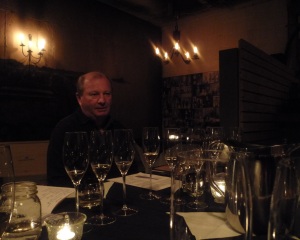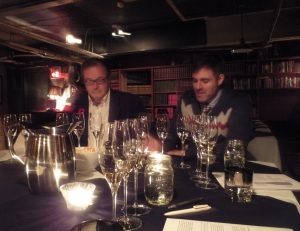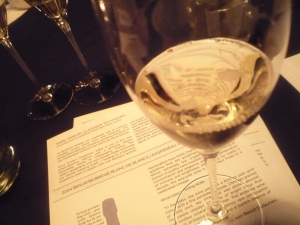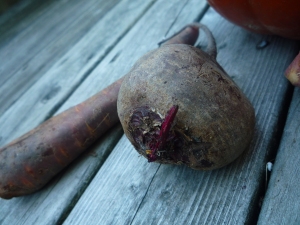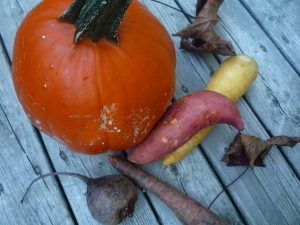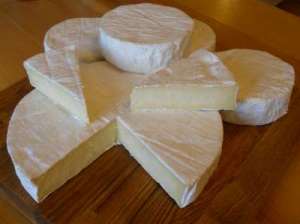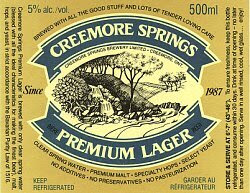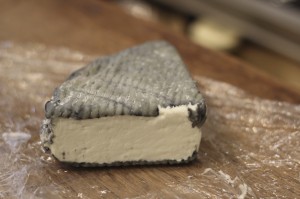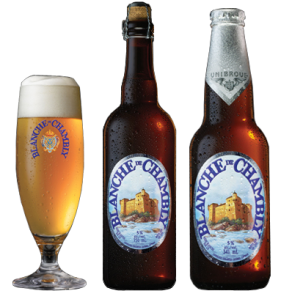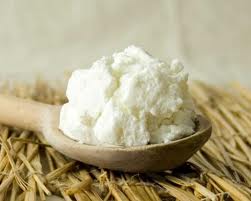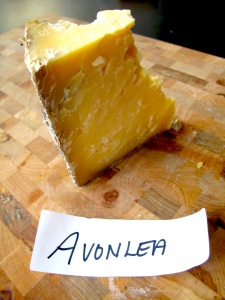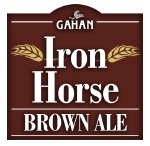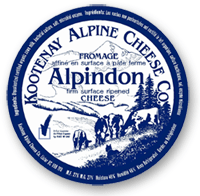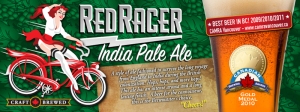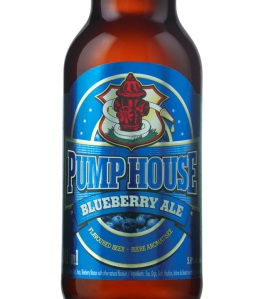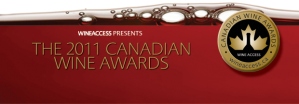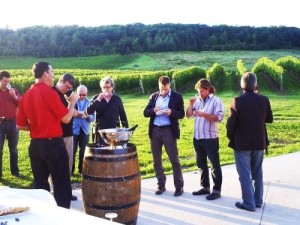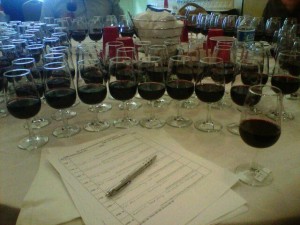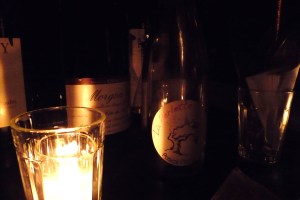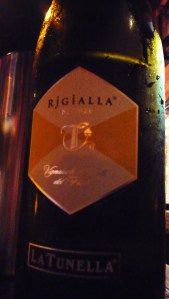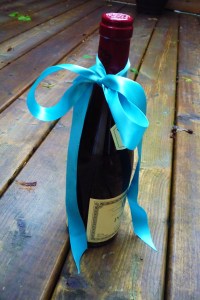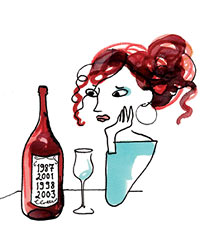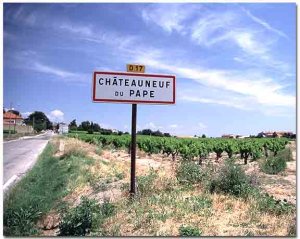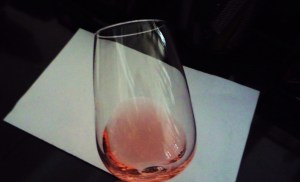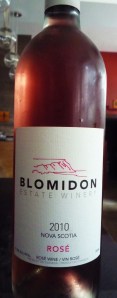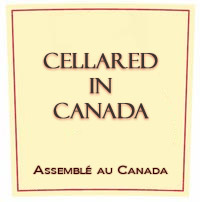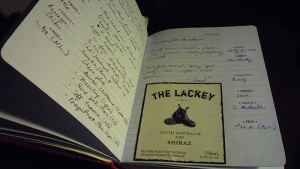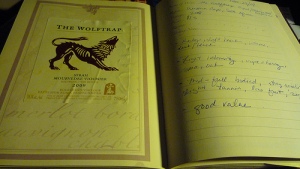Benjamin Bridge 04 Blanc de Blancs
November 13, 2013
Benjamin Bridge released their much-anticipated ’04 Blanc de Blancs last week. As has become custom, they invited by appointment small, like-minded groups to join owner and founder Gerry McConnell, wine-maker Jean-Benoit Deslauriers and chief consultant Peter J. Gamble to taste the results. The meeting spot was at Noble, a small, speak-easy style bar hidden in the basement of The Middle Spoon.
The vibe at Noble is suitably secretive and the ‘board-meeting’ set-up established an appropriate air of stateliness. (Though, a gripe if I may: the dim lighting, moody as it was, prevented a real look at the wine’s colour… and from getting a decent pic with my low-tech point-and-shoot!)
The cuvées of Benjamin Bridge have often been compared to the great houses of Champagne. But perhaps where BB is surpassing traditional Champagne methodologies – certainly those of the big houses – is in its nimble, Grower’s approach. All of BB’s bottlings have been site-specific and vintage to date. The grapes aren’t purchased from “all-over” and blended into a consistent house-style. Rather, they take an estate-focused approach: growing their own vines (or at least working very closely with their growers), crafting their own blends and bottling their own wines. They allocate time and resources to properly cultivate a terroir-driven product, carefully matching grape to place and meticulously monitoring activity in the vineyard. They are free to experiment in the winery (e.g. spontaneous and wild ferments) with the flexibility to meet the special needs of each project – all while interfering in the process as little as possible (which, as Jean-Benoit pointed out, is very much a conscious effort).
And as it turns out, Nova Scotia is not a bad spot to do it all in. We not only have a cooler climate than Champagne, but we often enjoy a longer ripening season, naturally lower cropping levels and higher grape acid levels. It was hinted at the tasting that perhaps the only other region besides ourselves and Champagne with similar conditions and potential is in and around the English South Downs – or, West Sussex and Hampshire (read: Nyetimber).
The Benjamin Bridge story is an inspiring one. A ten-year project involving some of the best minds and hands in the business (including the late, legendary Raphaël Brisbois of Piper-Heidsieck who was surprised to even find grapes in Nova Scotia, let alone ones to rival those of his homeland). They had one agenda: to make the very best sparkling wines possible. Throughout the project they’ve shown an almost obsessive attention to detail and a relentless pursuit of quality that is quite admirable.
Also in the tasting lineup was the ’09 Brut and ’07 Brut Reserve (already sold out at the winery). 2009 was their last year for hybrids and as of 2010 only vinifera appear in their Méthode Classique program.
The ’04 Blanc de Blancs is of course 100% Chardonnay – harvested from one of the coolest growing seasons in the last 2 decades. It spent 9 years on the lees. What struck me immediately was how alive, yet balanced it was – buzzing with acidity and at the same time exceptionally soft. Beyond this, I will simply re-quote Jean-Benoit and won’t bore you with my tasting notes! This wine is as much about appreciating the effort involved in creating it, as it is in enjoying the results.
“…brilliant pale gold colour with a fine persistent mousse. Complex aromas of white mint, key lime, and wet stones… The palate displays and array of bright citrus fruit and endless mineral undertones. This exquisite wine owes its brilliance to an extremely rare combination of richness and brightness and a superb balance of concentration and elegance.”
– Jean-Benoit Deslauriers
At $280 per bottle and with only 4 cases available for sale in NS (the rest going to the BB club, export and the family cellar) many will not get to try this remarkable sparkler. But, with an expected 15-20 years aging potential, this should give you ample time to find someone, somewhere with a bit in their cellar willing to share.
Reds Fit For Veggie Fare
October 12, 2013
Upon putting together a pairing flight for a roasted vegetable dish at the wine bar last week I discovered a commonly held belief among wine-drinkers: that wine and vegetables don’t mix – but if they must, then it’s got to be a light-bodied White.
My guess is that this stems from the notion that veggies are delicate and therefore can’t handle a robust wine. But, as with all food and wine marriages, the type of vegetable, how you cook it, and what you add to it makes all the difference and suddenly opens up all sorts of pairing possibilities.
- Firstly, autumn vegetables like beetroot, parsnips, turnip tend to be heartier than Spring or Summer ones (think, asparagus, artichokes).
- Secondly, roasting or caramelizing vegetables (as opposed to say, boiling or steaming) intensifies flavour, texture and sugars.
- Thirdly, adding fat, protein and grains to the dish – for example, in the form of cheese, nuts or barley – adds substance and weight.
Once you turn up flavour, add protein and fat, you’ve got yourself something that can quite easily take on and tame a tannic Red or woody White.
That said, this is still not grilled-steak territory, so when picking a veggie-friendly wine, I would avoid full-on, punchy Reds and veer toward something subtler: think, fruity with mild-moderate tannins, low alcohol and good acidity. For example: Rosé, Beaujolais, Chianti Classico.
The More We Get Together
August 6, 2012
I haven’t posted in ages. But, don’t worry, I won’t tire you with the poor-me-I-just-had-a-baby and I-hardly-have-time-to-drink-wine-any-more blather. (Even though that’s the truth.)
Allow me to celebrate my comeback with a post about beer. Actually, it’s a re-post. I initially wrote this for cheese-wizard Sue Riedl’s blog Cheese and Toast – whom I had the good fortune to meet last June at the Great Canadian Cheese Festival. Sue had tweeted an article on English beer & cheese pairings last month and I responded by suggesting we do a Canadian version. She agreed so I asked friend and beer wizard Craig Pinhey if he’d pick a few of his favourite Canadian brewskies, and I’d select cheeses to match and write it all up! Ta da!
What Grows Together, Goes Together
Canada makes phenomenal beer and cheese. But rarely do we think of pairing them together. “What grows together goes together” is a fundamental food pairing principle: by combining food and drink from the same region there are automatic similarities in aroma and flavour which set the foundation for a harmonious pairing.
Here we pick six of our favourite Canadian beers and pair them with an outstanding cheese from the same province. Try them yourself. You may never reach for potato chips and pizza with your brewski again.
1. Creemore Springs Premium Lager & Comfort Cream – Ontario
The combination of vibrant carbonation and sweet biscuit-like malt in this Lager make it an ideal partner for a rich, bloomy-rind, Camembert-style cheese.
Comfort Cream from Upper Canada Cheese Co. is an oozy, velvety, buttery cheese that loves the mouth-cleansing action of sudsy bubbles with just enough tartness to cut through the fat – enter, Creemore Springs Premium Lager. Because it’s not overly bitter, the beer doesn’t trump the cheese and accentuate unwanted undertones. True to Camembert form, the cheese offers classic mushroomy, earthy flavours which are right in step with the marked floral notes in this beer.
2. Blanche de Chambly & Grey Owl – Quebec
Wheat beer often goes well with goat cheese, but the pairing gets more interesting when good character is present in both.
Grey Owl, from Fromagerie Le Détour, has a mild, chalky, paste that is complex enough to hold its own, but doesn’t try to compete with the delicate spice of this white ale. The pairing really comes together on tangy, citrus notes with Blanche de Chambly’s orange and lemon tartness echoing the citrussy acidity of the cheese. Grey Owl’s ash-rind might be a tad too vegetal/green for this match if it weren’t for a prevailing coriander note in the ale that pulls it all together. Not your typical Wheat Beer/Goat cheeses pairing, to be sure!
3. Propeller Pale Ale & Ran-Cher Acres Chèvre – Nova Scotia
This mellow, balanced pale ale requires a younger, tamer cheese – but not so tame that the cheese disappears.
Moderate hoppy flavours are a good mate for tartness in a cheese – which this fresh goat’s milk cheese has plenty of. The chèvre is also fruity, picking up on similar elements in the beer (pear), and is delectably creamy, not sour. Ultra creamy cheeses like the Ran-Cher Acres Chèvre cry out for a crisp, cleansing, companion like the Propeller Pale Ale. A match made in Maritime heaven.
4. Iron Horse Brown Ale & Avonlea Clothbound Cheddar – PEI
The dark chocolate and roasted nut notes in this brew fuse perfectly with the creamy, rich, toffee flavours of this aged cheddar from Cow’s Creamery.
The beer completely winds itself around this cheese and does not let go. (Think: Caramilk bar… but better!) There is also a rustic, bitter edge to the Iron Horse which mimics the earthiness of the Clothbound – especially toward the rind – and provides a savoury/sweet contrast that is pretty unbeatable.
5. Red Racer IPA & Alpindon – BC
Fashioned after the Beaufort d’Alpage, Kootenay Alpine’s Alpindon is intense and complex – precisely what this racy IPA craves in a mate.
The Red Racer is a bit of a hop monster and so requires a cheese that is just as shouty. Part of the cheese’s pungency comes from its dark textured rind that has a lovely burnt, woodsy taste which highlights the brawny bitterness of the IPA. Tiny crystals nestled in the Alpindon’s paste add an exciting crunch and their buttery, herbaceous flavour sings against the beer’s caramel maltiness and florality.
6. Pump House Blueberry Ale & Marti – New Brunswick
The dominant element in both the Blueberry Ale and this Sheep’s milk cheese is a mild sweetness. Marti, made by Bergerie aux Quatre Vents, is a delicate fruity cheese with vanilla notes that couple brilliantly with the berry and malt characteristics of this fruit beer. The cheese’s rind is tender and without harsh flavours that might disrupt the softness of the Pump House. There is a subtle saltiness to the cheese which is nicely contrasted by sweet fruit and peppery notes in the ale. Both the beer and cheese are more or less equal in terms of flavour intensity – an important element to consider, even when similar flavours appear in both.
2011 Canadian Wine Awards
August 31, 2011
Last week the judging of the 2011 Canadian Wine Awards took place here in Halifax, Nova Scotia. The competition is in its 11th year and normally held in either Ontario or British Columbia. This year I was asked to judge on the panel along with 15 of the country’s top wine experts and writers.
The judging, and related events spanned four days (Aug 22-25) during which 1100 Canadian wines were tasted, evaluated and scored. The tasting was mostly blind – that is, the varietal or blend was known but no other information about the wine – price, vintage or producer – was provided.
In addition to the core tasting, judges had a packed social itinerary which involved getting whirled about the city (and outskirts) on a comprehensive culinary and wine expedition. Topping the agenda were personalized wine-paired dinners (Five Fishermen in Halifax, Tempest in Wolfville, Le Caveau in Grand Pré) and guided tours of our valley wineries and vineyards (Benjamin Bridge, L’Acadie Vineyards, Gaspereau Vineyards, Luckett Vineyards and Domaine de Grand Pré). Most judges were seeing NS wine country and tasting its wines for the first time; the bright acidity and balance of our L’Acadie Blanc, the fresh aromatics of NY Muscat and the richness and delicacy of our best-effort traditional method Sparklings. Add to the judges’ own writings and tweets there was local and national media coverage providing tremendous and necessary exposure for the NS wine industry.
The competition itself is an enormous and meticulously well-organized operation. The scope and scale of the judging is fascinating and truly eye-opening. Nearly 95 wines were tasted per day by each judge in a brightly lit cellar-temperature controlled room from about 8:30am till late afternoon. Themed flights of 10-12 wines were the norm with each wine individually evaluated and scored by each judge and discussed within the group for consensus. The better wines were tasted again in the Finals round and the stand-outs once more in the Best Ofs.
Going in, one of my top fears (in addition to making an idiot of myself) was palate fatigue. How does the palate stand up to the constant onslaught of sugar, acidity and tannin? Remarkably well it turns out, if the conditions are right. The time of day was key – the palate being perkiest in the morning, along with proper pacing, regular palate-cleansing, and old fashioned focus. I’ve experienced far more exhaustion and loss of concentration from a late-night Sommelier lecture flight, than at this marathon tasting. Illuminating.
The highlight for me personally, after meeting the extraordinarily skilled group of judges, was getting the full (or near to full) spectrum of Canadian wine. Much of my own tasting experience covers wine from other parts of the world. The Atlantic provinces see only a fraction of the wine produced in the rest of the country and even less from the top producers. Most Atlantic Canadian wine drinkers are more familiar with the wines of Oz than of the Okanogan, sadly.
Personal impressions: some outstanding single-varietal Whites, White Blends, Pinots and Sparkling wines. Red Blends, Cabs and Merlots were slightly more controversial with fierce tannins and big oak dominating in many cases.
I look forward to pouring over the results in the Winter 2011/2012 issue of Wine Access Magazine.
Hat Tip to The Ten Bells & Uva
June 21, 2011
This weekend had me in NYC catching up with friends and checking in on old haunts. It’s invigorating getting reacquainted with a city you once lived in, especially one like Manhattan where things are constantly changing. And with all that change usually comes new treats. Well, new-to-me at least. Like, The Ten Bells Wine Bar in SoHo.
Great atmosphere – small, convivial, rustic, with polished touches – a white marble bar top and funky industrial lighting. It’s cash only, and the menu is strictly chalkboard. At first the wine list appears small, but it’s well chosen with a good selection by the glass and bottle that changes regularly along with the food. At 8pm on a humid Friday night it was rammed with people spilling out onto the sidewalk. We managed to cluster around a high counter toward the back and settle on the Domaine Pascal Pibaleau “La Perlette” – a lightly sparking Rosé from Touraine made from the elusive Grolleau.
Domaine Pascal Pibaleau is a biodynamic producer with a focus on natural, organic farming methods including manual harvesting. The alcoholic fermentation for La Perlette is stopped partway through and the wine sits on its lees until disgorgement. Neither sulfur nor dosage is added. A fantastic wine! Lively but delicate fruit, chalky minerality, a touch herbacious, lightly petilant with balanced acidity and a dry finish. Fun to drink and a dream with the spicy octopus, chorizo and duck rilette we devoured.
Uva Wine Bar on The Upper East Side was the following night. Another sticky, late evening so we grabbed an outdoor table on their busy sidewalk patio. Specializing in Tuscan fare, it has a hefty wine list with an impressive Italian section. Uniquely, each wine is listed with the varietal in bold, followed by the producer, which I discovered was really handing for navigating (E.g. PECORINO IL FEUDUCCIO ’09 MARCHE 33) Most wines appeared to be single-varietals rather than blends, perhaps by design.
We ultimately decided on a Ribolla Gialla from Friuli-Venezia-Giulia, La Tunella “Rjgialla”. Very aromatic – lots of pear and quince on the nose with a touch of spice. I was expecting more fresh fruit on the palate but “cooked” fruit was what came through with a slight bitter/nuttiness I often get (and like) in good Italian whites. Solid structure, well balanced and very dry. My dining companion found it a bit too dry and a touch “gasoline-y”, but I think they too were expecting something fruitier. It has an odd flavour profile, not at all unpleasant but not your typical summertime, easy-drinking white. Personally, I liked it but it’s perhaps not for everyone.
You Shouldn’t Have…
June 13, 2011
A friend was visiting from out of town a few weeks ago. Upon arrival she plunked 2 handsome traditional-method sparkling wines on the counter for me. “You’ll love these”, she said as she wheeled her suitcase inside. Nothing more was said. I mention this because as I stare at my wine shelf (I have no cellar, for shame!) I observe a row of wines that, although were given to me, I feel I can’t drink. At least not without the people who gave them to me.
I’m sure you’ve experienced this juxtaposition: Someone gives you an outstanding bottle as a gift, with the caveat, “let’s open this some time together“. (Read: “don’t you dare drink this without me”) Now, I happen to be very fond of the people who’ve bestowed these wines on me and would be completely willing to share with them without even being asked… but, it feels less like a gift when the giver tells you what you’re allowed to/not do with it. It’s like your Gran handing you a fiver when you were a kid and saying, “now don’t go spending this on junk!”.
I fully appreciate the torture of parting with a good bottle and wanting very badly to enjoy some of that gorgeousness so generously being given away, but should you find yourself in this conflicted position, I offer some advice: Bring it to dinner instead. Or, invite the person over and open it together. If you must hand it over as an official pressie… do so condition-free.
As it happens, I opened one of those sparkling lovelies with said friend over dinner one night. The other one I took to a Sunday night kitchen party – where I was called a ponce (more or less) for bringing champers to a kitchen party… but the point is, I enjoyed it very much – in my own time and in my own way. I even shared it with other people.
Err, That’s Not What I Ordered…
June 3, 2011
An interesting discussion unfolded on Twitter a few nights ago on the topic of vintage discrepancies on restaurant wine lists. It started with the tweet:
A host of replies followed. Most people felt the restaurant should compensate the guest based on the argument: it’s not what was ordered. But a few sided with the restaurant and suggested that if vintage was so important to the customer, and the bottle was presented properly, it should have been checked upfront – i.e. they accepted it, their problem. Somewhere down the middle line was the opinion that whether or not to compensate really depends on the wine, the price, and how vintage-variant the wine is.
The wine in this case was a Châteauneuf-du-Pape. High profile wine, expensive and fairly vintage-sensitive. The vintage discrepancy was a 2005 (generally accepted to be a good year) and a 2008 (a not so good year). The former was listed on the menu, the latter was presented at the table. Midway through the bottle the guests discovered the error and brought it to the attention of their server. The group was mildly annoyed but content enough to keep drinking, no big fuss was made but there were intimations that something should be done (this is mild-mannered, non-confrontational Atlantic Canada, after all!)
Most restaurants interested in providing any level of customer service would do something. But what is appropriate? What is fair?
It is not uncommon for suppliers to deliver the wrong vintage to restaurants, and in most cases the price the restaurant pays does not change (except perhaps for premium/revered vintages). In this case the restaurant paid the same price for the 2008 as it did for the 2005 even though an ’08 Châteauneuf can retail for about 15% less than earlier (better) vintages.
Market prices aside, as far as the restaurant was concerned, the menu price was fair – it reflected their cost (they did not pay less for the 2008). But they did accept ownership of the menu error on the basis that perhaps the guest would not have ordered the Châteauneuf had it been listed as 2008, and they were keen to tidy up any bad feelings at the table. The restaurant decided to take 25% off the bottle price. Most members of the group seemed happy with this, but one contested: ” it’s still not what we ordered”. Remember, they were happy to keep drinking it.
It is an interesting discussion. Being in the industry myself and a regular diner-outer, I am frequently at both ends of table. If you take the pedantic viewpoint, there is responsibility on both sides: the customer to check that they’re receiving what they ordered, and the restaurant to dutifully keep on top of their cellar management (and by extension, their menu updates). But at the end of the day it is really about customer service, isn’t it? In my view, an unhappy customer has the potential to be much more costly than any “comp”, so if they are displeased, they mustn’t leave that way.
Springtime drinking: Blomidon Estate Rosé
May 22, 2011
Hard as it is for me to make the shift from the warming, heady Red wines of Winter, Springtime does call for something a bit less serious. Rather than leap directly to Whites, though, I prefer to take a gradual approach via the Pink to make the adjustment a little easier.
When it comes to Rosé, I am a bit selective. For me, the ideal template is undoubtedly Provençal: delicate, fruity, herbal. Insipid, sour, candy-like versions are unbearable, even with food (unless in a salad dressing). Unfortunately, Provence Rosé is hard to come by here in Nova Scotia, but wines sharing its profile can still be found if you take the time to look. Interestingly, one such findings is a local creation.
Blomidon Estate Winery recently released their 2010 Rosé – a blend of L’Acadie Blanc, Baco Noir and NY Muscat (a splash more Muscat than last year, I’m told). The colour is a healthy, coral pink with an entirely pleasant nose of strawberry, soft herbacious notes, rose petal and underlying lychee and blossom. The palate is lean, off-dry with lively fruit, bracing acidity and good backing minerality. The acid here is probably a bit more pronounced than that of a Provence rosé, but it’s still balanced and makes for an excellent food wine. Local seafood dishes simply prepared are a natural match. Mine, I had over a starter of local smoked salmon and fluffy creamy chevre on toasted baguette – it worked really well and started off the evening beautifully. Which is another good thing about rosé… by waking up the palate (rather than tiring it) it’s an excellent starting point for a wine-filled evening, if that’s on the cards.
Cellared In Canada
March 28, 2011
Firstly, your forgiveness for the 8 month absence! Opening a wine bar and finishing up a Sommelier program left me with little time/sanity for blogging. Hello again.
So, a month or so ago I gave a class presentation on the Cellared in Canada controversy. Afterwards, it was clear that few people had heard of the topic, let alone understood it. So, I thought a blog post was in order.
According to Wikipedia, Cellared in Canada is a term used to designate Canadian wine produced with varying quantities of Canadian and foreign bulk wine.
These varying quantities of foreign bulk wine (grapes, concentrates, juices) can be anywhere from up to 70% foreign-sourced content (in Ontario) to 100% (in BC). These wines are free to carry a label which states (more, or less) “Cellared in Canada from Imported and Domestic Wines”.
You may be starting to get a sense of what the fuss is all about.
The controversy is essentially two-pronged: one argument centers around language and labeling; the second around the winemaking practice itself. In a nutshell, the general criticisms are as follows:
1. It misleads the consumer (wording, shelving/store-placement)
The argument here is that “Cellared in Canada” (CIC) is intentionally misleading to consumers by implying that the wine – made largely or entirely with blends of imported wines – is Canadian. To add to the befuddlement, these wines are often placed in the Canadian section of liquor stores. Few attempts are made to educate the consumer by revealing where its imported content really comes from.
Most of this strife comes from within the industry – growers, winemakers, critics, writers etc. Many consumers (the ones we’re so worried about) are not even aware of CIC’s existence – never mind what it means. A recent Wine Intelligence Poll revealed that only 36% of Canadian wine drinkers were actually aware of the term, and only half of these people could correctly state its meaning. Once informed, however, over half thought the term was inappropriate and most of them wanted to see country of origin and percentage on the label at least.
2. It misrepresents and/or damages reputation of Canadian wine
Canada is capable of making top drawer wine. We’ve known this at home for some time and are finally gaining some merit and recognition world wide. Most agree that a wine created in Canada from foreign content is not a true expression of Canadian wine. But some feel CIC reflects poorly on the Canadian wine industry as a whole.
One prominent voice on this front is Jancis Robinson. Jancis can probably also be credited with unleashing the CIC debate on a grand scale. It was on a visit to Okanogan back in the Summer of ’09 where she learned of the practice. Disappointed with what she saw – and even more so the following Spring when she tasted, and rather liked, some of the best VQA Chardonnays at a tasting at Canada House in London – she called CIC “a disservice to real Canadian wine”. Many industry experts agreed with her and still do.
The supporters of CIC, however, say that the practice is necessary. 100% Canadian Wine is expensive and nearly impossible to compete at lower price points (i.e. the sub $10 category) without incorporating cheaper foreign wine. They also maintain that buying foreign juice supports a “growing wine industry” by supplementing small grape harvest years and stretching crops to produce more wine. Which leads to better financial security for the wineries and supports them through low-crop years.
Beyond these criticisms there are other problems, too. The program is currently monitored by the Canadian Standards Board – a voluntary standards association, rather than a federal regulatory body, with no force of law behind it. Most agree that this type of regulation is too loose and that CIC would benefit with stricter controls and governance.
There is also the issue of unfair competition. Smaller and medium-sized Canadian wine producers making wine from 100% Canadian grapes are unable to compete at the price points offered by big wineries (and it is the big wineries) bottling CIC wines.
The debate, though still considered important, has cooled somewhat in recent months and governments and big wineries are doing little to clarify the issues raised. Tighter regulation is still just a notion, but there has been some movement within the Wine Law/Canadian Food Inspection Agency recently around label transparency. Specifically, a proposal requesting that the source of foreign content be indicated: E.g.
“Made in Canada from [country or countries] grapes (or juices)” or “Blended in Canada from [country or countries] wines”
The bigger question of whether we should we be making CIC wines at all still looms. But personally, I think that’s more of a purist’s battle and not a huge worry of mine. Cheaper, knockoff versions of the real thing plague nearly every industry. There is a market for them, just as there is for the authentic product. The consumer decides which product they want to buy. The problems arise when the consumer is unable to make an informed decision about that product, or worse, they are duped.
So, the first step, I believe is to tackle transparency. Remove the tricky “Cellared In Canada” wording, clarify origin on labels and display these products accordingly on shop shelves. This would at least educate consumers so that they’re able to make an informed purchase.
-
- labMisrepresents and/or damages reputation of Canadian wine
- Unfair competition for small/medium sized Canadian wine producers, making wine from 100% Canadian grapes
- Too loosely regulated. Canadian Standards Board is a voluntary standards association, not a federal regulatory body, no force of law behind it
- Causes confusion for the consumer (wording, shelving/store-placement)
Wine Journal Woes
July 24, 2010
I keep a wine journal. A paper one. Much to the annoyance of family & friends I am rarely without one. I’ve filled several with tasting notes, labels and dribble marks of wines consumed over the last few years. Perhaps not surprisingly, this obsession has resulted in another fixation: optimum wine journal format.
Incredibly, the perfect wine journal is an elusive creature. One might think that with wine being around since 5000 BC, or thereabouts, wine journal design must be perfected by now… but no. Silly, impractical wine journal designs abound making shopping for a new one enough to drive a person to drink (and with no place to put one’s notes!)
Here are my thoughts on good wine journal construction:
1. Size. The size of the journal should be small enough for portability, but large enough to fit all your thoughts and scraps (e.g. labels). Think: book/novel sized. Teeny ones will fit in your purse/man-bag but so maddening to write in (and read from) that you will probably not use them.
2. Cover. The cover should ideally be made of some kind of wipe-able, durable material. Wipe-able, so that it stands up to spills and durable so that it stands up to transport and frequent access.
3. Layout. Simple is best – with the following considerations included:
a) Label pages. Ideally the journal contains pages for labels, positioned opposite the notes page so notes & label are viewable side-by-side. I think labels are an important aspect of note-taking and provide a visual cue for remembering wines better than the name alone. They’re also helpful (& more interesting) to others leafing through your journals while you’re cooking dinner.
b) Notes pages. Ideally the notes page should contain 6 fields: Name (at the top), Date, Varietal, Region, Vintage & Price (I usually write where I bought it here, too) with a spacious, free-form area for Tasting Notes. Anything beyond this is just extra noise and limits what you can write where. Numbered rating systems – unless you have a strict criteria upon which you consistently rate wines – are arbitrary and unreliable. Separate compartments for appearance/nose/palate/finish/food pairing etc. are unnecessary and constrict use of space.
c) Dividers. Initially, I was undecided, but lately I’ve been warming to the idea of dividers, or tabs to organise journal content into sections – e.g. Red, White, Fortified, etc. This is primarily for retrieval purposes (as anyone familiar with the pain of hunting for a specific wine in a 200-pg wine journal can relate to). Fixed dividers are inflexible since they dictate a set number of pages per category (they also define the category for you) but using a 3-ring binder-style journal with generic tabs solves this problem.
You can, of course go digital, and disregard all of this luddite mumbo-jumbo 🙂
